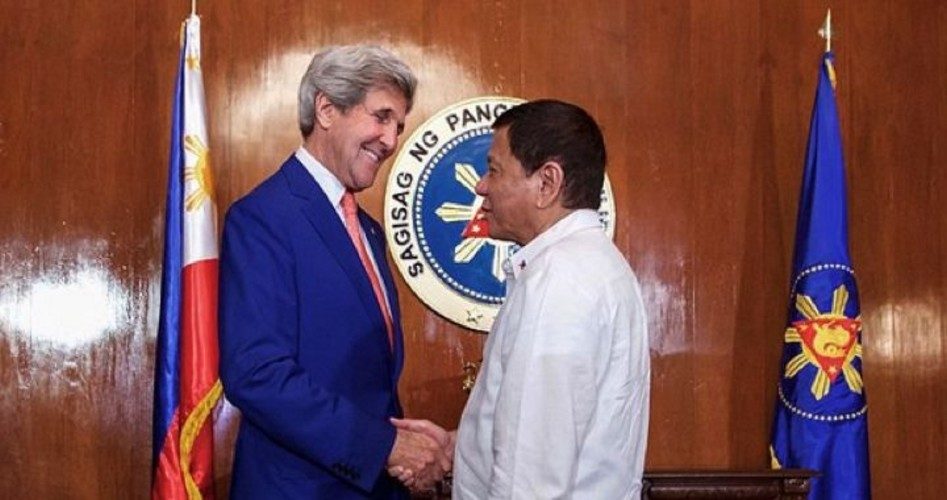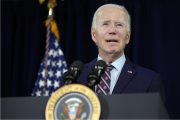
Philippines President Rodrigo Duterte (shown on right) made a statement on September 12 calling for the United States to withdraw U.S. Special Forces from Mindanao and other islands in his country’s southern region. In explaining his reason for calling for the removal of the U.S. forces, Duterte said that their presence inflamed Muslim insurgencies in the region.
Fox News reported that the U.S. troops were sent to the region in 2002 to train, advise, and provide intelligence and weapons to Filipino troops fighting against the al-Qaeda-linked militant group Abu Sayy. While most of those troops pulled out last year, a few U.S. military advisors remained.
As part of his reasoning to justify the removal, Duterte cited the killing of Muslims during a U.S. pacification campaign in the early 1900s, which he said was at the root of the long restiveness of minority Muslims in the predominately Catholic nation’s south. The United States took possession of the Philippines from Spain in 1898 after the Spanish American War, and the United States recognized the nation’s independence on July 4, 1946.
“For as long as we stay with America, we will never have peace in that land,” Duterte said in a speech to newly appointed government officials.
“The special forces, they have to go. They have to go in Mindanao, there are many whites there, they have to go,” he said. “I do not want a rift with America, but they have to go.”
Duterte said in his speech that U.S. colonial forces killed many Muslims in the southern Philippines more than a century ago “because you were here as imperialists, you wanted to colonize my country and because you had a hard time pacifying the Moro people.” (The Spaniards, who first occupied the Philippines after Magellan landed in the islands in the 16th century, called the natives of Mindanao “Moros,” meaning “Moors,” because they were Muslims. Spain had just driven the Muslim Moors from Spain and used the term for all Muslims.)
A Reuters report quoted a statement from Duterte that indicated his desire to remove the Americans from Mindanao was partially derived out of concern for their own well-being: “Americans, [the militants] will really kill them, they will try to kidnap them to get ransom.”
The day after Duterte’s call for the U.S. troop withdrawal from the Southern Mindanao region, Philippine Army spokesman Brigadier-General Restituto Padilla said in a statement, cited by Reuters: “We assure our people and allies that Philippine-US defense relations remain rock solid.”
“The recent pronouncement will affect only a token number of American servicemen who are confined mainly in Zamboanga City…. They [the U.S. troops] provide technical assistance and training to their Filipino counterparts in combating terrorism in the Philippines,” Padilla added.
A spokesman for the U.S. State Department, John Kirby, said in a statement cited by Reuters that his department was not aware of any official communication by Manila calling for a withdrawal. Kirby said Washington remained committed to the alliance with the Philippines.
A report in the Military Times last March noted that a new agreement had been reached between the United States and the Philippines that cleared the way for a new permanent U.S. military presence in five bases that will support rotational deployments near the contested South China Sea.
As we noted in an article in July, the Permanent Court of Arbitration (PCA), an international tribunal in The Hague, had ruled (in the case of Philippines v. China) in favor of the Philippines on July 12, in a maritime dispute with China over that nation’s construction of artificial islands in the Spratly Islands in the South China Sea.
However, it did not take long for China to defy the court’s ruling. China’s Supreme People’s Court (SPC) issued a regulation on August 2 stating that people caught illegally fishing in disputed Chinese waters in the South China Sea could be jailed for up to a year. This contested jurisdiction is naturally a source of friction among all of the nations claiming jurisdiction over the islands, which includes not only China and the Philippines, but also Taiwan, Vietnam, and Malaysia.
The increased military presence in the Philippines was noted in another Reuters report in April, which cited a statement from U.S. Defense Secretary Ash Carter saying that in addition to U.S. troops and military equipment being sent on regular rotations to the Philippines, the two countries had started joint patrols in the South China Sea in an apparent move to counterbalance China’s increasingly assertive territorial claims.
Carter said that a contingent of U.S. military aircraft and 200 U.S. airmen from U.S. Pacific Air Forces would be at Clark Air Base, a former U.S. Air Force base, through the end of the month. Clark, which was turned over to the Philippines in 1991, was the major departure point for U.S. aircraft supplying U.S. forces during the Vietnam War.
Reuters cited a Pentagon statement saying that the first U.S.-Philippines joint patrol in the South China Sea occurred in March and a second one happened early in April and would occur “regularly” in the future. The report also noted that the United States has recently conducted such joint patrols in the South China Sea with Japan.
The U.S. military presence in the Philippines, though relatively small compared with the 52,000 U.S. troops stationed in Japan and another 28,000 in South Korea, is indicative of the interventionist role that the United States has taken in Asia
This self-appointed role began at the end of World War II, when Japan was under U.S. occupation. The United States forced Japan to draft a constitution known as the “Post-war Constitution” or the “Peace Constitution,” best known for its Article 9, which states that “land, sea, and air forces, as well as other war potential, will never be maintained.” Though Japan does maintain a small military force, it is inadequate in face of potential threats from neighboring communist China, and even North Korea. China has 2,335,00 active military personnel, North Korea, 700,000, while Japan has just 250,000. Some Japanese political groups have called for either revising or abolishing the restrictions of Article 9, to permit the building of an adequate defense and strengthen Japan’s military capabilities.
With an active military strength of 625,000, South Korea is almost on a par with its bellicose neighbor to the north and should be able to defend itself, yet the United States also maintains 28,000 troops in that nation. The United States first sent troops to Korea in 1950 to form the bulk of the UN’s forces, and following the armistice that ended fighting there in 1953, we have maintained a military presence ever since.
In our article about North Korea’s recent test of a nuclear weapons, we offered several suggestions for breaking the cycle of interventionism and the web of entangling alliances that the United State has found itself enmeshed in since the end of World War II. We proposed:
We should encourage Japan to amend that constitution to enable it to do whatever is necessary to build up its military to defend itself.
We should also bring home those 28,000 U.S. troops stationed in South Korea and another 52,000 U.S. troops in Japan. Those forces should be defending the United States, not other countries. We might help friendly nations in Asia, including not only Japan and South Korea, but also the Philippines and Taiwan, to strengthen their military capabilities, by selling them military technology, such as aircraft. But these should be commercial, for-profit transactions, not foreign aid.
In an article published last March by the Ron Paul Institute, former Representative Ron Paul (R-Texas), who was an outspoken advocate of a noninterventionist foreign policy for the United States during his years in Congress, questioned the need to “rebuild” the U.S. military. He noted:
Russia, which the neocons claim is the greatest threat to the United States, spends about one-tenth what we do on its military. China, the other “greatest threat,” has a military budget less than 25 percent of ours.
In his article, Paul spoke about the controversy we just noted between China and the Phillipines over islands in the South China Sea. He wrote:
Last week the Pentagon announced it is sending a small naval force of US warships to the South China Sea because, as Commander of the US Pacific Command Adm. Harry Harris told the House Armed Services Committee, China is militarizing the area. Yes, China is supposedly militarizing the area around China, so the US is justified in sending its own military to the area. Is that a wise use of the US military?
The US military maintains over 900 bases in 130 countries. It is actively involved in at least seven wars right now, including in Iraq, Syria, Pakistan, and elsewhere. US Special Forces are deployed in 134 countries across the globe. Does that sound like a military that has been gutted?
As he continued, Paul stated:
The best way to really “rebuild” the US military would be to stop abusing the military in the first place…. Unlike the neocons who are so eager to send our troops to war, I have actually served in the US military. I understand that to keep our military strong we must constrain our foreign policy. We must adopt a policy of non-intervention and a strong defense of this country. The neocons will weaken our country and our military by promoting more war. We need to “rebuild” the military by restoring as its mission the defense of the United States, not of Washington’s overseas empire.
Duterte would like us to take our special forces out of Mindanao. We should be glad to accommodate his wishes. We might then go a step further by cancelling that agreement between the United States and the Philippines for a new permanent U.S. military presence in five bases in the Philippines. We can then move on to recommend to South Korea and Japan that they build up their military forces so they can defend themselves. Our troops can then do what they are supposed to do — go home and defend the United States.
Related articles:
Philippines President Threatens to Withdraw From UN
U.S. Military Presence in Okinawa Fuels Continued Protests
Controversy Over U.S. Base in Okinawa
Japan Hesitates on U.S. Bases in Okinawa
North Korea Claims to Test H-Bomb
North Korea Issues Threats During U.S.-S. Korean Joint Exercise


